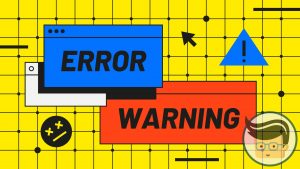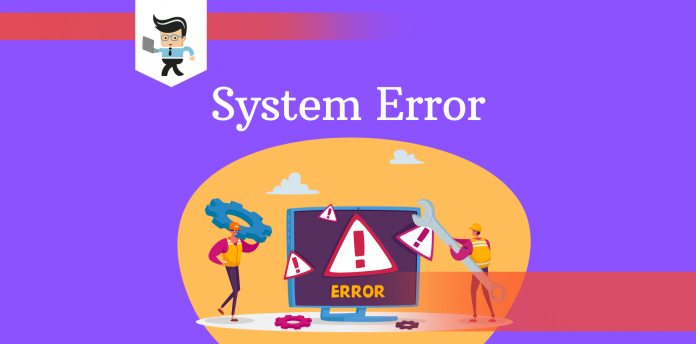Page_fault_in_nonpaged_area – If you’re a Windows user, you must have come across this error at some point. It shows up against the dreaded Blue Screen of Death (BSOD) with the error code 0x00000050 and ends with your computer crashing.
While it mostly occurs when your system refers to invalid memory, there can be other reasons, too. Read on as we discuss the various solutions to this problem.
Contents
Why Is The page_fault_in_nonpaged_area Happening?
 The computer stores data on different components like the RAM and the hard drive. When these components are full, the data is swapped between the page file and RAM.
The computer stores data on different components like the RAM and the hard drive. When these components are full, the data is swapped between the page file and RAM.
So when the system requires data stored on the Page file and isn’t able to find it, you end up seeing the “page fault in nonpaged area” error on a blue screen.
The Reasons Behind the Error
In some cases, the error syntax might include the cause of the issue, like ‘Page_fault_in_nonpaged_area (ati.sys). Here, the .sys file indicates that the program was trying to get access to parts of memory that it shouldn’t.
In other cases, there might be no indication of the underlying issue and it can either be software or hardware-related. It doesn’t just take place out of the blue; it usually takes place after an app or Windows update, a change in the graphics card or RAM, or after you installed something new.
Some other causes of this error include:
- System referencing to discharged memory or incorrect memory addresses
- Antivirus software and online security solutions that prevent the OS from finding the required data in the nonpaged area
- Incorrect Windows service
- Corrupted NFTS volume
- Wrong driver codes detected in the system
- Faulty or corrupt hardware, such as the RAM, causing the requested data to be lost
How To Fix page_fault_in_nonpaged_area
Since there are a number of reasons for this nonpaged area error, you will have to try out a number of solutions to solve the problem. Below are some common fixes that usually get rid of the error.
– Check Your RAM
If you have just recently added new hardware to your Windows PC, it’s a good idea to inspect if everything is properly fixed in its respective slot. Sometimes you can end up with faulty RAM sticks, or your old ones can also malfunction, which is why you should also check the RAM.
To do so, first, switch off your system and disconnect all the wires.
Then, below are listed some points you can do:
- If you have two memory sticks added to your computer, switch their slots to see if that solves the problem. Or, just try using one slot.
- If you only have one stick, take it out and clean it to get rid of any accumulated dust.
- If you have a spare RAM chip at home, try replacing it with the one on your computer and restart it. If you don’t see the error, then it means your RAM is faulty.
– Rollback, Update or Uninstall Drivers
Faulty device drivers can cause a plethora of problems, which is why it’s best to update them. The BSOD error usually occurs because of faulty chipset, graphics, audio, or display drivers, and you should update those if checking the RAM doesn’t solve the problem.
The simplest way to keep your drivers updated is by using the Device Manager. You can find the graphics drivers under the Display adapter and chipset drivers under System devices.
Here’s how you can manually update your drivers:
- Press the R and Windows keys together to launch the Run dialog box. In the text box, type devmgmt.msc and press Enter. This will open the Device Manager.
- You will see a catalog of drivers on the screen. Choose the one you want to update and click on it to expand the menu.
- Right-click on the particular driver you want to update. Then click on Update driver.
- On the next screen, click on “Search automatically for updated driver software.”
- The latest drivers will automatically be downloaded and installed.
However, in some cases, the latest updates can be unstable and can result in error. If that’s the case, you should roll back your drivers to their previous, stable versions. If you still see page_fault_in_nonpaged_area on the screen, try uninstalling the drivers altogether.
– Disable Automatic Paging Management
 The paging file directly deals with virtual memory and is often the culprit behind the page_fault_in_nonpaged_area error.
The paging file directly deals with virtual memory and is often the culprit behind the page_fault_in_nonpaged_area error.
Typically, your Windows manages the paging file. However, it’s best to disable it if it’s making your system crash.
Here’s how:
- Open up File Explorer.
- Right-click on This PC and choose Properties.
- On the panel on the left side of the screen, click on Advanced system settings. This will open up the System Properties. Just make sure you’re signed in as the admin.
- Under the Advanced tab, you’ll see a section for Performance along with a Settings button. Click on that. This will display up the Performance Options window.
- Go to the Advanced tab, and in the Virtual Memory section, click on Change.
- Uncheck the box that says “Automatically manage paging file size for all drives” and click OK.
- Apply the settings and reboot the PC.
If your computer works fine once you reboot, then you don’t need to do anything else. However, if you still see the page_fault_in_nonpaged_area problem on a blue screen, revert all the changes and check the box that says “Automatically manage paging file size for all drives.” Then apply the changes.
– Run chkdsk
Chkdsk or check disk is a disk checking utility that finds and fixes file system and disk errors. Here’s how you can run it:
- Run the Command Prompt as the administrator.
- In the cmd, type chkdsk /f /r and hit Enter.
- Let the process run. If you see the message, “The drive is locked. If you would like to schedule a chkdsk on the next restart, press Y for yes,” type Y and hit Enter.
- Reboot your computer and allow chkdsk to run. It will automatically fix any errors it finds.
– Use Windows Memory Diagnostics Tool
The Memory Diagnostic is a built-in Windows utility tool that checks for problems in the RAM and repairs them. It’s highly effective for fixing the page_fault_in_nonpaged_area issue.
Here’s what you have to do:
- Open up the Windows Memory Diagnostic tool.
- You will see two options: restart now & check for problems or check for problems next time you start the computer. We recommend choosing the first option.
– Repair Corrupted System Files by Using SDC and DISM
Since it’s difficult to understand the exact underlying cause of the page_fault_in_nonpaged_area error, it’s advisable to try repairing your system files, too. And you can do that with two Windows utilities: SFC and DISM.
To run DISM:
- Type cmd in the search bar in the Start menu. This will show the Command Prompt. Right-click on it and then click on Run as administrator.
- Now, in the command center, type DISM/Online/Cleanup-Image/CheckHealth and hit Enter.
- Next, type DISM/Online/Cleanup-Image/RestoreHealth and press Enter.
- Once the process completes, you can exit the Command Prompt. This will fix the system files.
To run SFC:
- Open up the Command Prompt as you did previously.
- Type in SFC/scannow in the console and hit Enter.
- Allow Windows to scan and fix errors.
- Once the process finishes, restart the computer.
– Do a Clean Boot
In most cases, third-party software applications interfere with normal system functionality and result in the page_fault_in_nonpaged_area error. To make certain this is not the cause; you should do a clean boot. Here’s how:
- Press the R and Windows Key to open the Run dialogue. Type in msconfig in the text box and hit Enter. This will open up the System Configuration window.
- Now go to the Services tab. At the bottom of the screen, you will see a checkbox with the text “Hide all Microsoft services.” Check that box.
- Make sure all the services in the list are checked and then click on Disable all. Click on save and then exit.
- Now, launch Task Manager by using the Start menu or by pressing the Shift, CTRL, and Esc keys together.
- In the Startup tab in the task manager, click on a program and then click on the Disable at the bottom left. Alternatively, you can right-click on the program and click on Disable. Do this for all programs.
- Once you’re done, exit the Task Manager and restart your computer.
If you no longer see the page_fault_in_nonpaged_area error, it means a third-party application was responsible for it. For extra measure, you should uninstall any application you recently installed to make sure you don’t experience this problem again.
– Update Your Windows
An outdated Windows can also be the cause of the page_fault_in_nonpaged_area fault. And you can rule it out by updating your OS. To do so:
- Type “Check for updates” in the search menu on Start. Click on it to open up System Settings.
- Your system will now check for any missing updates.
- You’ll see pending updates or outdated drivers on the screen, if there are any. Click on Install Updates to update everything.
- Once all the pending updates are done, restart your PC.
Disable Your Antivirus
At times, your antivirus can also be the reason for the page_fault_in_nonpaged_area problem. Antivirus and anti-malware software tend to conflict with hardware or software, causing your system to throw stop errors at you.
Try disabling the antivirus to see if the page_fault_in_nonpaged_area issue goes away. It’s rare, but it’s worth trying.
Reset Your PC
If everything else fails, the last thing you can do is reset your PC. To do so:
- Open up Windows Settings and go to Updates & Security.
- Go to the Recovery tab from the left side of the screen.
- On the main screen, you’ll see the Reset this PC section along with a Get Started button. Click on that.
- The system will now ask if you want to keep your hard disk contents or delete them. We recommend that you remove all the files so that you also remove whatever is causing the error.
The process will take a while. Just make sure you back up all the important files before resetting your PC.
FAQ
– What Is page_fault_in_nonpaged_area Windows 11?
Page_fault_in_nonpaged_area (50) is an error that occurs when the computer refers to any invalid memory. It often comes with the screen of death and results in your computer crashing. This error is the same as the page_fault_in_nonpaged_area Windows 8 error.
– Can Page Fault in Nonpaged Area Occur Because of Bad RAM?
Yes, this error can occur because of memory issues. These issues can be with not just the RAM but also the L2 and L1 caches on the CPU or even the video RAM on your graphics card. The only way to diagnose the exact reason is by eliminating possible causes.
– Does Page Fault in Nonpaged Area Harm Your Computer?
 This error can be harmful to your system, especially since it abruptly stops your computer while performing its tasks. Plus, it seems to appear multiple times until you finally solve the issue.
This error can be harmful to your system, especially since it abruptly stops your computer while performing its tasks. Plus, it seems to appear multiple times until you finally solve the issue.
This is why you should try to solve it when you notice the error for the first time.
Conclusion
Constantly being interrupted by a blue screen that says page_fault_in_nonpaged_area can be very annoying, especially if it comes between you and your work. In some cases, you also end up losing important data that your computer was unable to save before it crashed.
But, there are some more things you can try, like:
- Make sure your RAM is working properly.
- Update outdated drivers. If that doesn’t solve the problem, roll back to the previous stable version or completely uninstall the driver if the issue persists.
- Disable automatic paging management to see if that solves the issue.
- Run chkdsk, Windows diagnostic, DISM, and SFC to fix corrupted files that might be causing the error.
- Do a clean boot to check if third-party software applications are responsible for the problem.
- Disable the antivirus and update your Windows.
With luck, you will no longer encounter this error. However, if the error persists, you should take your system to an authorized dealer and let professionals handle the repair.







